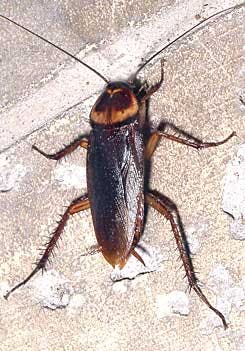
Roaches


Gallery

Additional Information
By Susan Jones
Roaches have few natural enemies. They are adaptable and extremely hardy, able to survive 30 days without water and up to three months without food. They prefer carbohydrates, and feed on almost any vegetable material; they have even been known to eat the starch in book bindings. In addition to damaging orchids, roaches are a health hazard, carrying disease-causing bacteria harmful to humans.
Life Cycle
Roaches are primarily nocturnal and thrive in home and greenhouse conditions. Prolific breeders, an egg-laying female can produce several thousand offspring in a single year. Eggs hatch into nymphs that molt several times before maturity. The adults of some species fly.
Symptoms
Roaches enter orchid pots through drainage holes. Outdoor plants are especially vulnerable, particularly if kept on the ground. Roaches are nocturnal feeders, so their presence is usually noticed only after plant damage (nibbled flowers, root tips and roots and new growth) has occurred.
Prevention
To keep roaches out, close off cracks around pipes and electric lines in the home or greenhouse with cement or screening. Keep the growing environment clean and free of leaf litter that provides food and cover. Indoors, caulk cracks along baseboards, walls, cupboards and around pipes, sinks and bathtub fixtures. Seal food tightly, do not leave pet food out, rinse used dishes left overnight and restrict access to water.
Controls
Approaches to managing roaches include natural repellents, dusts, baits and mechanical controls. The effectiveness of each method may vary, and combinations of treatments may be necessary.
Repellents
The following sprays can be used alone or in combination:
-- Dr. Bronner’s Eucalyptus or Peppermint Soap: 2 ounces per gallon of water (57 ml per 4.5 l).
-- Garlic or Rosemary oil: 3 ounces per gallon of water (85 ml per 4.5 l), with a teaspoon (5 ml) of mild dishwashing soap as a spreader/sticker.
-- Insecticidal soap, mixed per package instructions.
Baits
Because roaches will eat other dead and dying roaches, baits provide primary and secondary control. Roaches learn to avoid chemically treated products so chemical baits lose effectiveness long-term. Simple, homemade baits can also be useful.
Inside the home, set equal parts borax and granulated sugar in small shallow containers placed near where roaches are found. Borax is toxic to humans and pets and should not be used in areas accessible to either. Baking soda is a nontoxic borax substitute; it is said to be equally lethal to roaches.
To maintain effectiveness, borax must remain dry — a challenge around plants requiring regular watering. A simple, clever way to achieve this, suggested by Greg Allikas, West Palm Beach, Florida, involves boric acid tablets (available in grocery stores) and empty 35mm film cans. Squeeze a few drops of white glue (such as Elmer’s) in the bottom of the cans and drop a couple of boric acid tabs into the glue. Let the glue dry, then set the film cans horizontally on the surface of the plant’s medium. Edibles such as molasses or sugar syrup may be added to the tablets, but roaches will eat plain borax and the sweets may also attract ants.
Predators
Many lizards eat roaches, and may be released into an enclosed outdoor growing area. They are sensitive to insecticides and pesticides, so are an option only where such controls are not used.
Mechanical Controls
Place cockroach sticky traps in areas roaches frequent, and where exposure to water is unlikely to impede their effectiveness. Once full, traps can be discarded.
To drive roaches from a potted orchid, immerse the pot, over the top of the media, in water. Roaches will emerge to avoid drowning, and can be dropped into a pail of hot soapy water, killing them.
Insecticide
Three applications of products containing Diazinon, Dursban or Baygon at two-week intervals, sprayed deep into cracks and crevices, will kill successive generations. Always use any chemical in strict accordance with manufacturer’s instructions.
References
Moschetti, Rocco. Low Toxicity Pest Control Bulletin: Diatomaceous Earth and Silica Aerogel. IPM Alaska.
Orchid Pests and Diseases. Growing Orchids in Canberra. Orchid Society of Canberra, Australia.
Strunk, Timothy.Solving Pest Problems: Cockroaches. Western Michigan University, Division of Student Affairs.
Swicegood, Carolyn. Safe and Natural Pest Control: Cockroaches. The Land of Vos Web site.
Susan Jones was the editor of Awards Quarterly and assistant editor of Orchids. American Orchid Society, 16700 AOS Lane, Delray Beach, Florida 33446
All reuse must contain the follwing:
Reprinted from the SEPTEMBER 2003 issue of Orchids -- The Bulletin of the American Orchid Society. Copyright American Orchid Society --www.aos.org

FREE ACCESS: Orchid DealWire
Get notified when orchid vendors have special promotions and exclusive savings.



